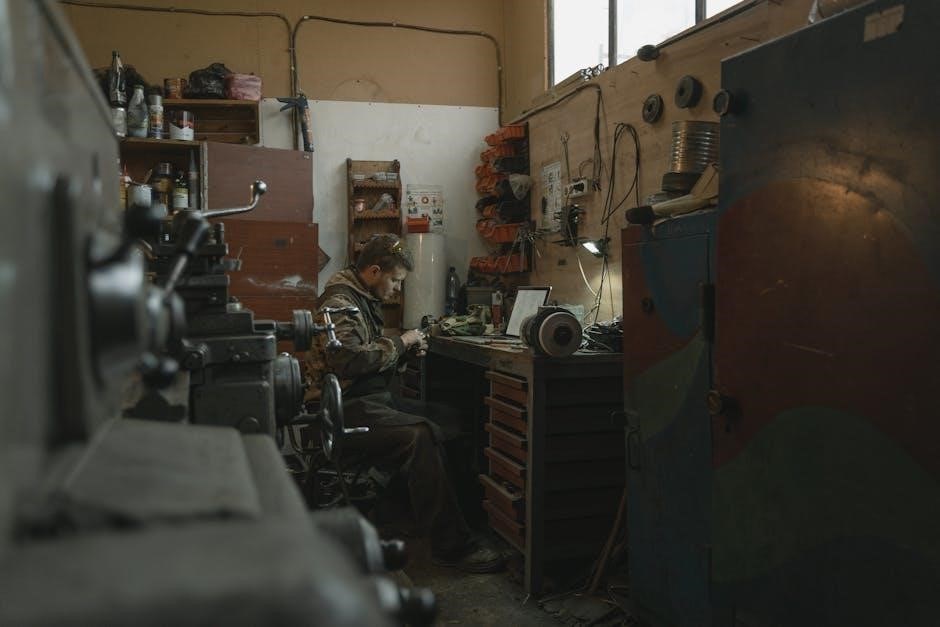
angle grinder guide
Discover the best tips, tricks, and safety advice for using an angle grinder. Learn how to cut, grind, and polish like a pro!
An angle grinder is a versatile power tool used for grinding‚ cutting‚ and polishing various materials. Portable and efficient‚ it is essential for numerous industrial and DIY tasks. Always prioritize safety when operating.
1.1 What is an Angle Grinder?
An angle grinder is a portable power tool designed for cutting‚ grinding‚ and polishing various materials like metal‚ concrete‚ and stone. It uses rotating discs with abrasive surfaces to perform tasks efficiently. Compact and versatile‚ it is widely used in both professional and DIY projects. Safety is crucial when operating‚ as the high-speed disc can pose risks. Proper technique and protective gear are essential for safe and effective use.
1.2 Brief History and Evolution
The angle grinder traces its origins to the early 20th century‚ evolving from basic mechanical grinders. Over the decades‚ it transitioned from heavy‚ stationary tools to portable‚ electric versions. The 1980s saw significant advancements‚ with improved motor designs and ergonomic handles. Modern angle grinders now feature variable speed control‚ cordless options‚ and advanced safety features. This evolution has made them indispensable for professionals and DIYers alike‚ offering precision and versatility across various materials and tasks.

Types of Angle Grinders
Angle grinders come in electric‚ pneumatic‚ and cordless models‚ each offering unique benefits for different tasks and environments‚ ensuring versatility in various applications and settings.
2.1 Electric Angle Grinders
Electric angle grinders are the most common type‚ offering high power and versatility for cutting‚ grinding‚ and polishing. They typically operate between 4500 and 8500 RPM‚ making them suitable for tough materials like metal and stone. These grinders are popular in workshops and DIY projects due to their ease of use and availability. Variable speed models allow for precise control‚ enhancing efficiency across various tasks. Always use appropriate discs and safety gear to ensure safe operation.
2.2 Pneumatic Angle Grinders
Pneumatic angle grinders are powered by compressed air‚ offering consistent performance in heavy-duty applications. They are commonly used in professional settings for tasks like cutting metal‚ grinding welds‚ and polishing surfaces. Lightweight and durable‚ these grinders provide excellent control and reliability. Regular maintenance‚ such as checking air pressure and lubrication‚ is essential for optimal performance. Pneumatic grinders are ideal for environments where electricity is unavailable or hazardous‚ ensuring safe and efficient operation in industrial and construction settings.
2.3 Cordless Angle Grinders
Cordless angle grinders offer unparalleled portability and convenience‚ making them ideal for remote jobsites. Equipped with advanced battery technology‚ they deliver consistent power without the constraints of a cord. These grinders are perfect for cutting‚ grinding‚ and polishing in tight spaces. Lightweight designs reduce fatigue‚ while adjustable speed settings ensure precision across various materials. Cordless models are gaining popularity among professionals and DIYers alike‚ providing the freedom to work efficiently anywhere‚ anytime‚ with minimal setup and cleanup.
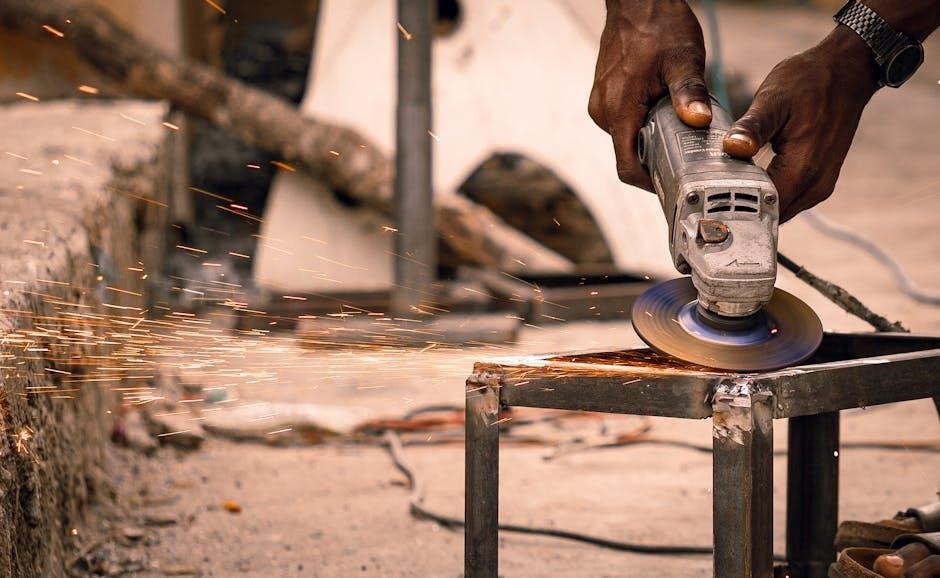
Uses of an Angle Grinder
An angle grinder is a versatile tool for cutting‚ grinding‚ and polishing various materials. It excels at tasks like cutting tiles‚ removing rust‚ sharpening blades‚ and smoothing surfaces efficiently.
3.1 Cutting Various Materials
An angle grinder is highly effective for cutting various materials‚ including tile‚ stone‚ concrete‚ steel‚ and metal. Equipped with the right disc‚ it ensures precise and clean cuts. Diamond cutting discs are ideal for tough materials like stone and concrete‚ while abrasive discs work well for metal. Always maintain the correct angle and apply steady pressure for optimal results. Safety gear‚ like goggles and gloves‚ is essential to protect against flying particles. Proper disc selection and technique ensure efficient cutting across different surfaces‚ making it a versatile tool for diverse projects.
3.2 Grinding and Smoothing Surfaces
An angle grinder excels at grinding and smoothing surfaces‚ ensuring a polished finish. Hold the grinder at a 15- to 30-degree angle for optimal results. Use appropriate discs for different materials—abrasive for metal‚ diamond for stone. Apply steady‚ consistent pressure to avoid unevenness. Regularly inspect the disc for wear and replace as needed. Always wear safety gear to protect against debris. This technique is crucial for preparing surfaces before painting or further processing‚ ensuring a professional-quality finish every time.
3.3 Polishing and Sanding
Angle grinders are ideal for polishing and sanding surfaces‚ achieving a smooth finish. Use flap wheels or sanding discs for metal‚ while diamond discs work best for stone. Start with coarse grit for heavy smoothing and progress to finer grits for polishing. Maintain a steady‚ controlled motion to avoid uneven results. Always wear protective gear‚ including gloves and safety glasses‚ to prevent injury from flying particles. Regularly inspect and replace worn discs to ensure consistent performance and desired surface quality.
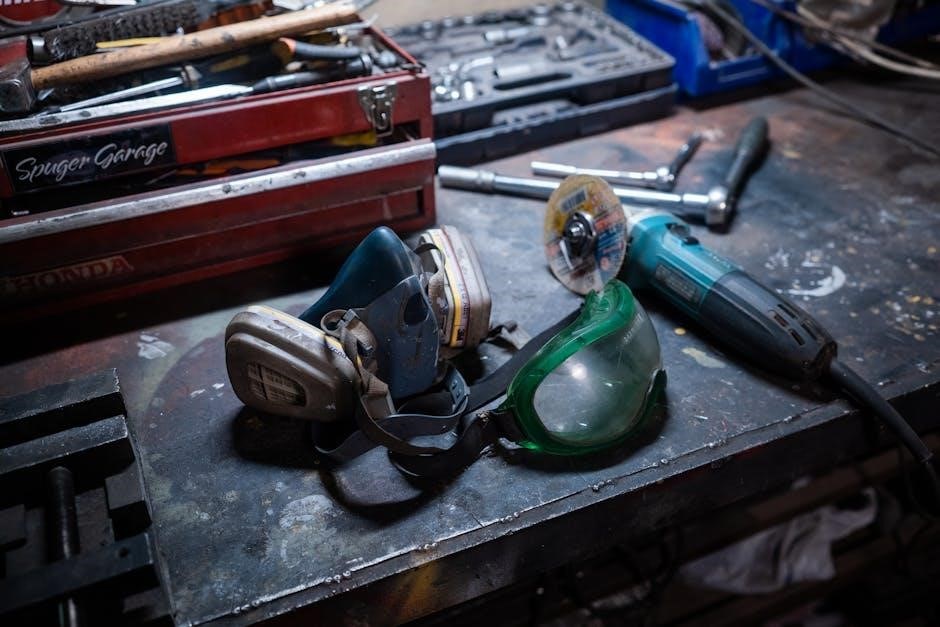
Safety Instructions and Precautions
Always wear a face shield‚ gloves‚ and dust mask. Ensure loose clothing is tied back and avoid using damaged cords. Keep the grinder switched off before plugging in. Never use a cord to carry or pull the tool. Follow all safety warnings to prevent serious injuries from particles or kickback.
4.1 Essential Safety Gear (PPE)
Protective gear is crucial when operating an angle grinder. Always wear a face shield to guard against flying particles and sparks. Safety glasses provide additional eye protection. Use durable gloves to maintain grip and prevent cuts. A dust mask is essential for inhaling fewer particles during grinding. Steel-toe boots and loose-fitting clothing tied back reduce injury risks. Proper PPE ensures safety and minimizes hazards associated with cutting and grinding tasks.
4.2 General Power Tool Safety Warnings
Always read and follow the manufacturer’s instructions and safety warnings. Avoid operating the grinder in explosive or flammable environments. Never use the tool near open flames or sparks. Ensure the work area is well-ventilated and clear of clutter. Store the grinder properly when not in use. Keep children and bystanders away. Never use a damaged or malfunctioning tool. Regularly inspect the grinder and its accessories for wear or damage. Failure to adhere to these warnings can result in serious injury or accidents.
4.3 Proper Handling Techniques
Always maintain a firm‚ controlled grip on the grinder‚ with hands away from moving parts. Stand with a stable stance to prevent loss of balance. Hold the grinder at a 15- to 30-degree angle for optimal control. Apply steady‚ consistent pressure without forcing the tool. Avoid overreaching or stretching‚ as this can reduce precision and increase risk. Keep the workpiece firmly secured to prevent movement during operation. Use the correct technique for the task‚ whether cutting or grinding‚ to avoid disc binding or kickback.
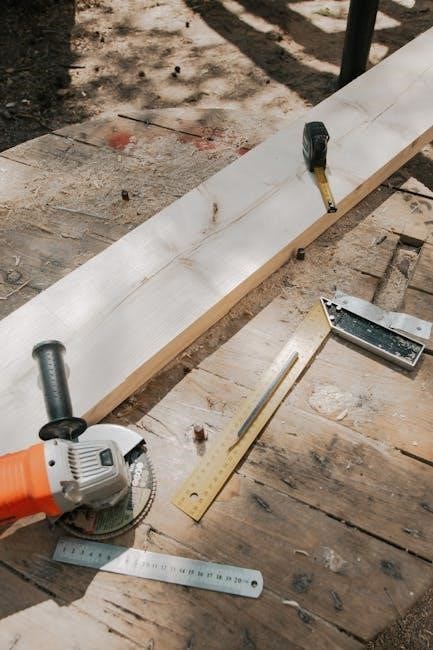
Choosing the Right Disc for Your Angle Grinder
Selecting the correct disc ensures efficiency and safety. Match the disc type to the material and task‚ whether cutting‚ grinding‚ or polishing‚ for optimal results and longevity.
5.1 Types of Grinding and Cutting Discs
Grinding and cutting discs vary in materials and purposes. Diamond discs excel for cutting stone‚ concrete‚ and tough materials‚ while abrasive discs are ideal for metal grinding. Flap discs are perfect for smoothing and polishing surfaces. Each disc type is designed for specific tasks‚ ensuring efficiency and precision. Always choose the right disc for your material to achieve optimal results and extend tool longevity.
5.2 Diamond Cutting Discs
Diamond cutting discs are renowned for their exceptional sharpness and durability. They feature diamonds fixed on the edges‚ making them ideal for cutting hard materials like tile‚ stone‚ and concrete. These discs offer precise cuts and long lifespan‚ reducing the need for frequent replacements. Their high performance ensures efficient cutting‚ making them a favorite among professionals and DIYers alike. Always follow manufacturer instructions for optimal results and safety.
5.3 Selecting the Correct Disc for the Task
Selecting the right disc for your angle grinder is crucial for optimal performance and safety. Discs are designed for specific tasks‚ such as cutting‚ grinding‚ or polishing. Always match the disc type to the material you’re working with‚ whether it’s metal‚ stone‚ or concrete. Look for labels or pictures on the disc packaging to ensure compatibility. Follow manufacturer instructions for RPM settings and usage guidelines to avoid damage or injury. Proper disc selection enhances efficiency and ensures safer operation.

Operating an Angle Grinder
Start the grinder safely‚ allowing it to reach full speed before making contact. Maintain the proper angle and avoid kickback by keeping a firm grip and controlled motion.
6.1 Starting the Grinder Safely
Before starting‚ ensure the grinder is switched off and unplugged. Inspect the disc for damage and secure it tightly. Wear proper PPE‚ including safety glasses and gloves.
Plug in the grinder and let it reach full speed before making contact with the workpiece. Avoid sudden movements and maintain control throughout the operation. Always follow the manufacturer’s instructions for safe startup procedures.
6.2 Maintaining the Proper Angle
Maintain the grinder at a 15- to 30-degree angle for optimal control and effectiveness. This angle helps prevent the tool from slipping and ensures even contact with the workpiece.
For cutting tasks‚ keep the disc between the 2 o’clock and 3 o’clock position to minimize kickback risk. Adjust the angle based on the material and task‚ ensuring stability and precision throughout the operation.
6.3 Avoiding Kickback and Binding
Kickback and binding are common hazards when using an angle grinder. To avoid them‚ avoid applying excessive pressure‚ which can cause the disc to bind.
Always use the correct disc for the task and ensure it is properly secured; Keep the grinder moving steadily and maintain control.
Never grind on the side of the disc‚ as this increases the risk of kickback.
Use light‚ consistent pressure and keep the tool well-balanced for safer operation.

Maintenance and Troubleshooting
Regularly clean the grinder and store it in a dry place. Inspect and replace worn or damaged parts promptly to ensure optimal performance and safety.
7.1 Cleaning and Storing the Grinder
Always turn off and unplug the grinder before cleaning. Remove any dust or debris with a soft brush. Store in a dry‚ cool place away from direct sunlight. Regularly inspect the grinder and accessories for wear or damage. Ensure all parts are clean and dry before storage to prevent rust. Keep the grinder out of reach of children. Proper storage and maintenance will extend the tool’s lifespan and ensure safe operation.
7.2 Replacing Worn or Damaged Discs
Turn off and unplug the grinder before replacing discs. Remove the old disc by loosening the spindle lock. Inspect the disc for wear or damage. Select a suitable replacement disc for your task. Follow the manufacturer’s instructions for proper installation. Tighten the disc securely to avoid vibration. Always wear safety gear during replacement. Ensure the new disc is compatible with your grinder’s size and speed rating. Proper installation ensures safety and optimal performance. Regularly check discs for wear to maintain efficiency and prevent accidents.
7.3 Common Issues and Solutions
Common issues with angle grinders include uneven grinding‚ overheating‚ and disc wear. For uneven grinding‚ ensure the disc is properly aligned and secured. Overheating can be resolved by allowing the grinder to cool down and using the correct speed setting. Worn discs should be replaced promptly to maintain performance. If the grinder vibrates excessively‚ check for imbalanced discs or loose parts. Always refer to the manufacturer’s troubleshooting guide for specific solutions. Regular maintenance and proper usage can prevent most issues and extend the tool’s lifespan.
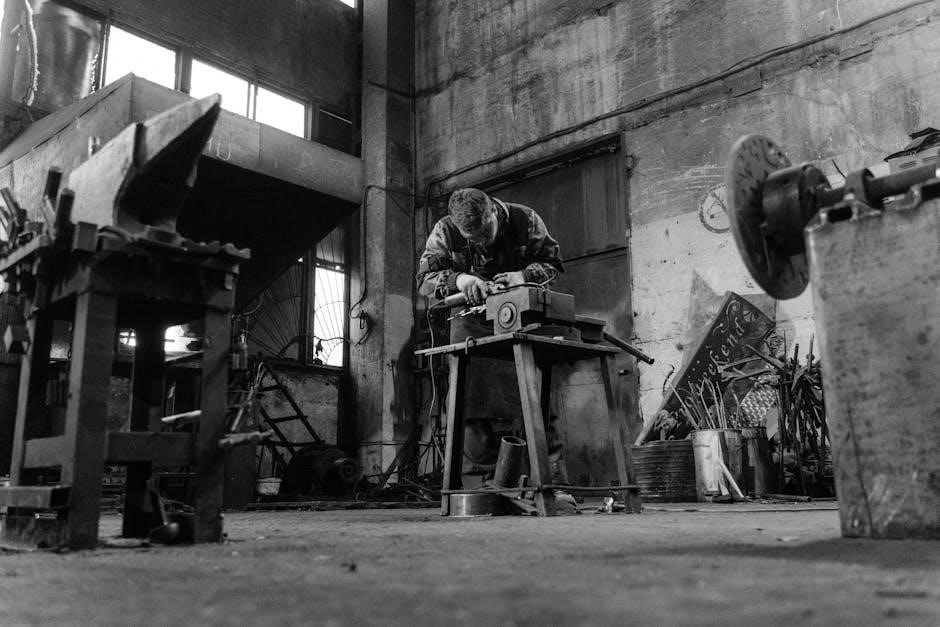
Accessories for Angle Grinders
Accessories like additional handles‚ dust extraction systems‚ and specialized attachments enhance functionality. Follow manufacturer guidelines for optimal performance and compatibility with your angle grinder model.
8.1 Additional Handles and Attachments
Additional handles and attachments for angle grinders enhance control and versatility. Auxiliary handles improve grip and reduce fatigue during extended use. Specialized attachments‚ such as wire brushes or sanding pads‚ expand the tool’s capabilities. These accessories ensure optimal performance for various tasks‚ from polishing to heavy-duty cutting. Always choose compatible attachments and follow manufacturer instructions for safe and effective operation. Properly fitting accessories are crucial for maintaining tool efficiency and user safety.
8.2 Dust Extraction Systems
Dust extraction systems are essential for minimizing airborne particles during grinding and cutting. These systems‚ often integrated with vacuums‚ capture debris effectively. Using a HEPA-filter vacuum ensures cleaner air and reduces dust inhalation. Properly fitted extraction systems improve visibility and workplace safety. Regular maintenance of these systems is crucial for optimal performance. Always ensure compatibility with your angle grinder model for efficient dust collection and a safer working environment.
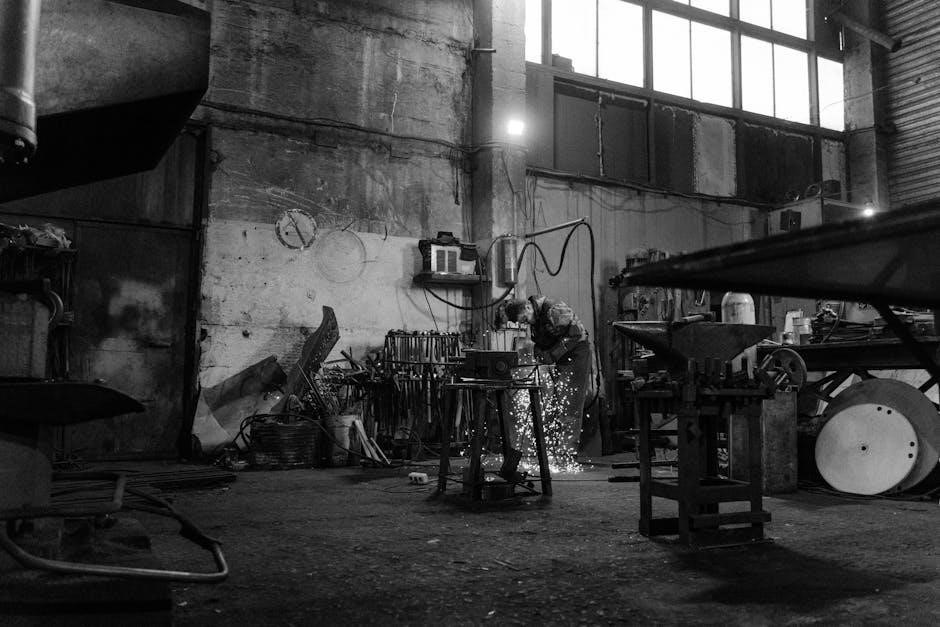
Angle Grinder Buying Guide
Consider power source‚ disc size‚ and intended use when selecting an angle grinder. Cordless models offer portability‚ while electric grinders provide consistent power for heavy-duty tasks.
9.1 Factors to Consider When Purchasing
When buying an angle grinder‚ consider the power source (electric‚ pneumatic‚ or cordless)‚ disc size‚ and RPM for task suitability. Ergonomic design and weight are crucial for comfort. Check safety features like emergency shut-off and vibration control. Assess the durability and brand reputation. Budget plays a role‚ but prioritize performance for intended use. Additional accessories‚ like interchangeable handles‚ may add value. Ensure compatibility with desired discs and attachments for versatility in various projects.
9.2 Budget vs. Performance
Budget and performance are key considerations when selecting an angle grinder. Higher-priced models typically offer better durability‚ higher RPM‚ and advanced features like variable speed control. For occasional use‚ a mid-range grinder may suffice‚ balancing cost and capability. However‚ for heavy-duty tasks‚ investing in a premium model ensures longevity and efficiency. Evaluate your needs to determine the optimal balance between budget and performance‚ ensuring the tool meets your workload demands without unnecessary expense.
Advanced Projects with an Angle Grinder
An angle grinder excels in advanced tasks like cutting tile‚ stone‚ and concrete‚ sharpening blades‚ and removing rust and paint. Its versatility makes it ideal for complex DIY and professional projects‚ allowing precise and efficient results across various materials.
10.1 Cutting Tile‚ Stone‚ and Concrete
Cutting tile‚ stone‚ and concrete with an angle grinder requires precision and the right tools. Use a diamond cutting disc for clean‚ efficient cuts. Start by marking the material‚ then apply steady pressure while maintaining a consistent angle. Keep the grinder at a 15- to 30-degree angle for optimal control. Always wear safety gear‚ including goggles and a dust mask‚ to protect against flying debris. Regularly check the disc for wear and replace it as needed for best results.
10.2 Sharpening Blades and Tools
Sharpening blades and tools with an angle grinder is a practical skill for maintaining equipment. Use a grindstone or diamond wheel for precise edge restoration. Hold the grinder at a consistent angle and apply light pressure‚ moving the blade evenly across the wheel. Avoid overheating the blade by cooling it periodically. Regular sharpening extends tool life and improves performance. Always follow safety guidelines and test the blade’s sharpness by cutting through paper after sharpening.
10.3 Removing Rust and Paint
An angle grinder is ideal for removing rust and paint from metal surfaces. Use a wire brush wheel for rust and a sanding disc for paint. Apply steady‚ even pressure and work in small sections to avoid overheating the metal. This method effectively restores surfaces to bare metal‚ ready for recoating. Always wear protective gear‚ including gloves and goggles‚ to prevent injury from debris. Regularly inspect the disc for wear and replace it as needed for optimal results.
11.1 Final Tips for Effective Use
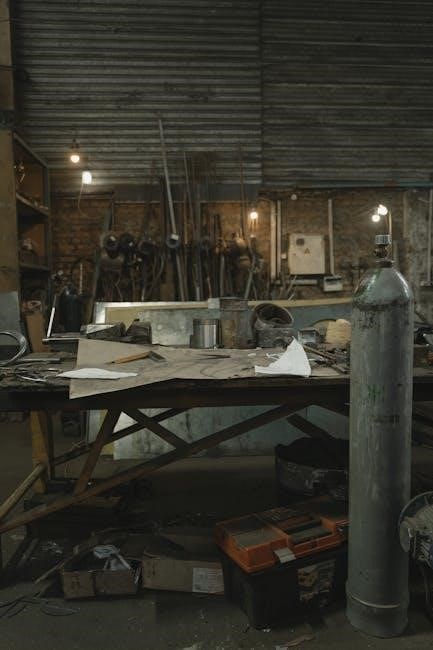
Always maintain a firm grip and keep the grinder at the recommended angle. Use the correct disc for the task to ensure efficiency and safety. Regularly inspect the tool and discs for wear. Start the grinder at low speed before applying it to the material. Avoid overreaching and keep loose clothing tied back. Store the grinder and discs properly after use to prolong their lifespan and ensure safe handling.
11.2 Encouragement to Practice and Explore
Don’t be afraid to experiment and explore the full potential of your angle grinder. Start with simple tasks like cutting tile or smoothing surfaces‚ then gradually move to more complex projects. Practice makes perfect‚ so keep refining your skills. Explore different discs and techniques to expand your capabilities. Remember‚ safety and patience are key to mastering this versatile tool. Enjoy the process of learning and creating!